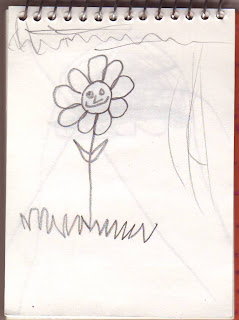two river cities-
“don’t leave out the sex scenes,” a
stranger proposes
I'm interrupting my Sketches series with something a little different today. The haiku above is just a preview of my experience, which I've written up as a short story below. You may recall that I posted a bit about psychogeography a while back, on Valentines Day. While I still haven't had a chance to walk my heart-shaped route, I did find the time to play another city-exploring game, inspired by this brochure on the theory of the derive. Without further ado:
Montmartre, Edmonton
Two river cities: I put Paris over Edmonton, and try
to see through the paper – the North Saskatchewan and the Seine crossing each
other and merging. I pick out a thumb tack – rouge – place its point at Montmartre, and press it through both maps.
Then, I tear away the Parisian page, leaving only the map of Edmonton. The
thumb tack marks my destination.
I like to go looking for a story – to map my way
towards a plot and, in navigating, find myself in the middle of it. When I was
in Paris, I took the metro to Montmartre, and, fittingly, my Edmonton route takes
me on the LRT. I wait ten minutes for the train, knowing that in Paris, three
would have passed in that time. While I wait, a man approaches me, wants to
know the time (ten to two, or quatorze
heures moins dix), and asks to buy a train ticket from me for $1.75. I turn
him down – “I only have a pass,” I say. When travelling, I’ve been taught to
keep my wallet hidden, and politely decline any requests made by unknown men: non, désolée.
At the point of the red thumb tack, there’s a small
playground half-buried in snow. Perhaps the slide corresponds in location to a boulangerie on the narrow streets of
Montmartre. Driven by thoughts of fresh bread, and too cold to write outside, I
find not a boulangerie, but “The End
Zone Pub and Grill.”
Two men stand outside the door, smoking. I pick my
seat by the window, and a few minutes later, they come inside. They traverse
the pub with a familiarity that reminds me I am a foreigner here; as they take
six easy steps from the door to the bar, I see that the dark carpet is worn
pale along their path.
I order a hot chocolate (chocolat chaud, I say to myself), and a small soup: chicken noodle.
The hot chocolate is made from a mix, but they’ve stirred it well, and besides,
it’s warm. I start to write.
The stereo plays some kind of thumping pop, the sort
of thing that was popular in France when I was there. “You’re so beautiful, so
damn beautiful,” goes the refrain. They listen to English music in Paris too –
it’s très cool.
One of the men from outside sits down at the next
table. His jacket is faux leather, worn enough that it could almost pass for
real. After a few sentences, he turns, and asks me what I’m writing.
“A story,” I say.
“What’s it about?”
“It’s a travel story,” I decide. “About Paris.” Is
that a lie?
He asks me if I’ve been to Paris, and I tell him yes,
and when he asks what it’s like, I make a comment about the weather. I don’t
tell him that, in a way, I’m in Paris right now. That I’m within walking
distance of the Moulin Rouge. That
really, so is he.
We talk for a while – the conversation of strangers,
the first words you learn in any foreign language. Not “where is the bathroom,”
but “my name is Erika, comment t’appelles
tu?” He asks about school, about what I’ll do next. I tell him I’ll
probably go down to the states to study. It’s a good idea, he thinks. “Up here
in Canada, we need priests, but down there, they need people like you.” I’m not
sure about the accuracy of his market analysis, but I agree anyways. When I
reach the bottom of my hot chocolate, wet powder clings to the mug – I was
wrong, I suppose, about it being well-stirred.
My soup arrives in a Styrofoam bowl – “sorry for the
wait” – and the man offers me some advice about writing. “Live it, learn it,
and make it exciting.” It sounds good to me, and he adds, “don’t leave out the
sex scenes.” I laugh, and he raises his beer. “Cheers.” I think that those
words will be the last line of my story, start thinking of French translations
– chin, santé, à la votre, salut – but he turns around to speak to me again.
“So did you fall in love out there?” He’s talking
about Paris. When I tell him no, he continues.
“What are your likes and dislikes? I mean, what are
your tastes in men?”
I’m taken aback and, awkwardly, I mention my
boyfriend. He laughs. “I’m just flirting with you, that’s all.”
I laugh too, relieved that it’s been made explicit. He
adds, “you’re beautiful, you know?” and I think of France, and the song that
was playing when I came in. So damn beautiful.
“I’m single,” he says, “but I would marry you in a
heartbeat.”
He goes back to his beer, and I try the soup that’s
been cooling as we talk. I write with one hand, hold the spoon with the other, and
when I’m about halfway through, the man gets up to leave, giving me a nod on
the way out. I watch him walk out into the cold and across the street before
turning back to my notebook. After a few more lines, I decide to leave the last
chunks of chicken in the bottom of the Styrofoam bowl.
































